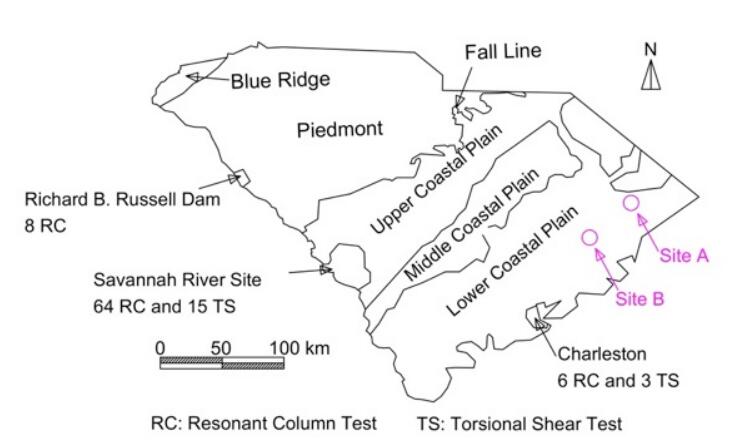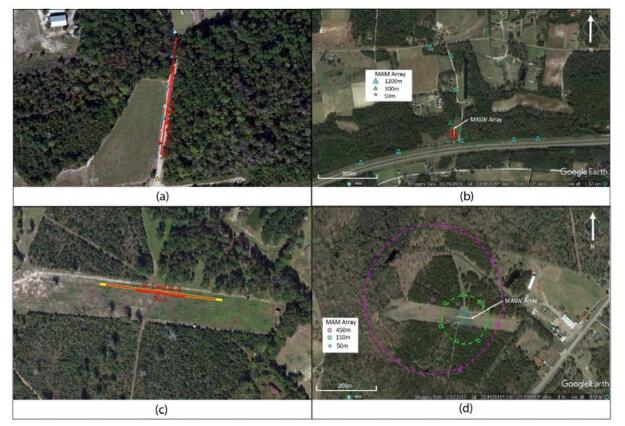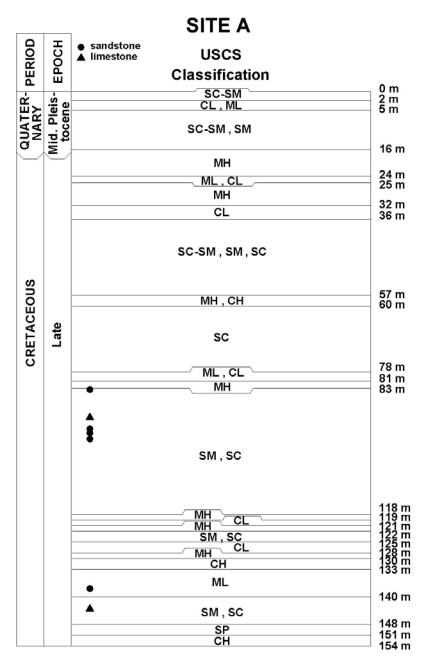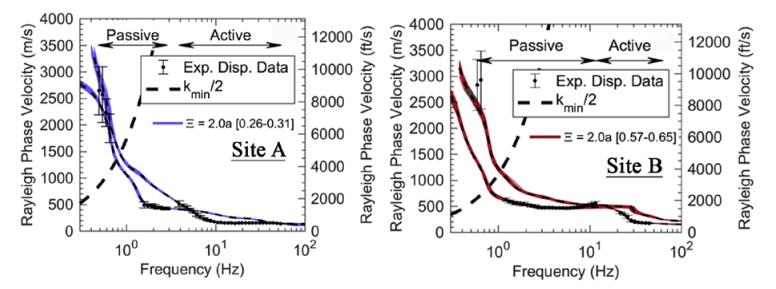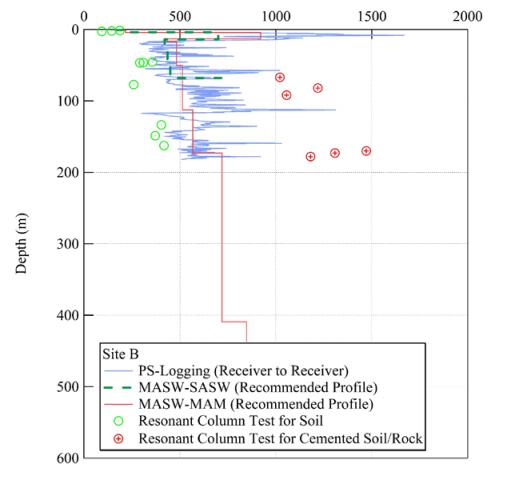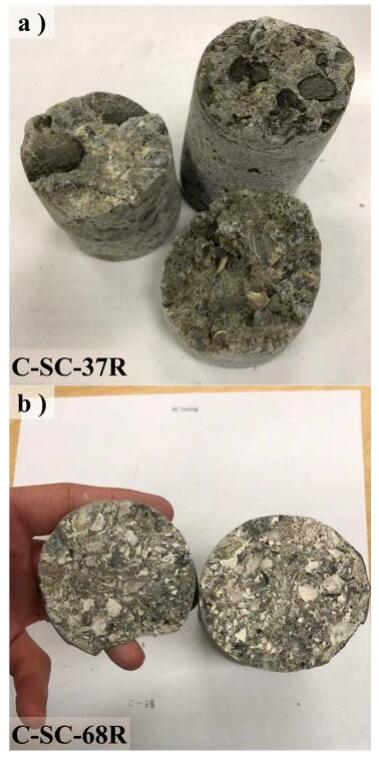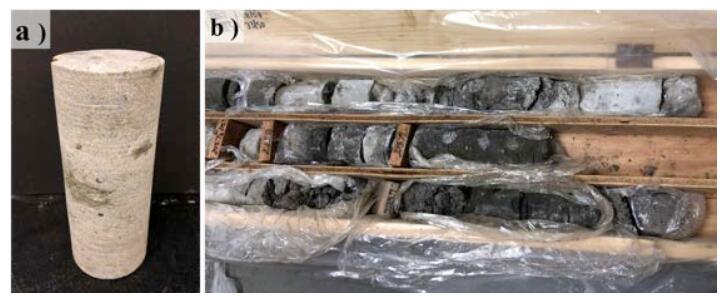The Atlantic Coastal Plain is a geological formation along the east coast of the United States that consists of unconsolidated sediments as thick as 1000 m underlain by very hard rock with shear wave velocity, V s of over 2600 m/s. In South Carolina, this very hard rock layer is located close to or at the ground surface in the central part of the state, and increases in depth towards the coast, and from north to south. The deep sediments are mostly Cretaceous and younger in age and consist of unlithified sediments with weakly lithified units. The deep sediments are unique geological and geotechnical conditions that pose significant challenges to seismic hazard analyses. Having an accurate V s profile for the deep sediment is critical for predicting the level of ground shaking at a particular site. Geotechnical borings were drilled at two locations to depths of approximately 150 m and 190 m for borehole geophysical testing, undisturbed sampling, and soil/rock coring. Geophysical testing was conducted independently by groups of experts at both locations and included P-S suspension logging, a combined multi-channel and spectral analysis of surface waves, and a combined multi-channel analysis of surface waves and microtremor array measurement methods. This paper presents a comparison between field testing results from the different methods and visual classification of soil and rock samples to evaluate uncertainties of deep soil profiles obtained by different methods. In addition, soil samples collected at both sites were tested using the resonant column method to evaluate dynamic properties. The shear wave velocities measured in the lab for soil and rock samples were compared with results from the field measurements. Cementation was found to be one of the important factors affecting the shear wave velocity measurements.
1.
Introduction
Rough set theory was initially developed by Pawlak [1] as a new mathematical methodology to deal with the vagueness and uncertainty in information systems. Covering rough set (CRS) theory is a generalization of traditional rough set theory, which is characterized by coverings instead of partitions. Degang Chen et al.[2] proposed belief and plausibility functions to characterize neighborhood-covering rough sets. Essentially, they developed a numerical method for finding reductions using belief functions. Liwen Ma[3] defined the complementary neighborhood of an arbitrary element in the universe and discussed its properties. Based on the concepts of neighborhood and complementary neighborhood, an equivalent definition of a class of CRS is defined or given. Bin Yang and Bao Qing Hu [4] introduced some new definitions of fuzzy-covering approximation spaces and studied the properties of fuzzy-covering approximation spaces and Mas fuzzy covering-based rough set models. On this basis, they proposed three rough set models based on fuzzy coverage as the generalization of Ma model. Yan-Lan Zhang and Mao-Kang Luo[5] studied the relation between relation-based rough sets and covering-based rough sets. In a rough set framework based on relation, they unified five kinds of covering-based rough sets. The equivalence relations of covering-based rough sets and the type of relation-based rough sets were established. Lynn Deer et al. [6] studied 24 such neighborhood operators, which can be derived from a single covering. They also verified the equality between them, reducing the original set to 13 different neighborhood operators. For the latter, they established a partial order showing which operators produce smaller or larger neighborhoods than the others. Li Zhang et al.[7,8] combined the extended rough set theory with the mature MADM problem solving methods and proposed several types of covering-based general multigranulation intuitionistic fuzzy rough set models by using four types of intuitionistic fuzzy neighborhoods. Sang-Eon Han [9,10] set a starting point for establishing a CRS for an LFC-Space and developed the notions of accuracy of rough set approximations. Further, he gave two kinds of rough membership functions and two new rough concepts of digital topological rough set. Qingyuan Xu et al.[11] proposed a rough set method to deal with a class of set covering problem, called unicost set covering problem, which is a well-known problem in binary optimization. Liwen Ma[12] considered some types of neighborhood-related covering rough sets by introducing a new notion of complementary neighborhood. Smarandache[13] proposed the concept of neutrosophic sets in 1999, pointing out that neutrosophic sets is a set composed of the truth-membership, indeterminacy-membership and falsity-membership. Compared with previous models, it can better describe the support, neutrality and opposition of fuzzy concepts. Because of the complexity of practical problems in real life, Wang et al.[14] proposed interval neutrosophic sets(INS) and proved various properties of interval neutrosophic sets, which are connected to operations and relations over interval neutrosophic sets. Nguyen Tho Thong et al.[15] presented a new concept called dynamic interval-valued neutrosophic sets for such the dynamic decision-making applications. Irfan Deli[16] defined the notion of the interval valued neutrosophic soft sets, which is a combination of an interval valued neutrosophic sets and a soft sets. And introduced some definition and properties of interval valued neutrosophic soft sets. Hua Ma et al. [17,18] utilized the INS theory to propose a time-aware trustworthiness ranking prediction approach to selecting the highly trustworthy cloud service meeting the user-specific requirements and a time-aware trustworthy service selection approach with tradeoffs between performance costs and potential risks because of the deficiency of the traditional value prediction approaches. Ye jun[19] defined the Hamming and Euclidean distances between INS and proposed the similarity measures between INS based on the relationship between similarity measures and distances. Hongyu Zhang et al.[20] Defined the operations for INS and put forward a comparison approach based on the related research of interval valued intuitionistic fuzzy sets. Wei Yang et al.[21] developed a new multiple attribute decision-making method based on the INS and linear assignment. Meanwhile he considered the correlation of information by using the Choquet integral. Peide Liu and Guolin Tang[22] combined power average and generalized weighted agammaegation operators to INS, and proposed some agammaegation operators to apply in decision making problem.
In recent years, many scholars have studied the combined application of rough sets and neutrosophic sets. In order to make a comprehensive overview for neutrosophic fusion of rough set theory Xue Zhan-Ao et al.[23] defifined a new covering rough intuitionistic fuzzy set model in covering approximation space, which is combined by CRS and intuitionistic fuzzy sets. They discussed the properties of lower and upper approximation operators and extended covering rough intuitionistic fuzzy set in rough sets from single-granulation to multi-granulation. Hai-Long Yang et al.[24] proposed single valued neutrosophic rough sets by combining single valued neutrosophic sets and rough sets. They also studied the hybrid model by constructive and axiomatic approaches. Hai-Long Yang et al.[25] combined INS with rough sets and proposed a generalized interval neutrosophic rough sets based on interval neutrosophic relation.They explored the hybrid model through the construction method and the axiomatic method. At the same time, the generalized interval neutrosophic approximation lower and upper approximation operators were defined by the construction method. In this paper we will study the interval neutrosophic covering rough set (INCRS), which is combined by the CRS and INS, and discuss the properties of it. Further we will give the complete proof of them. In order to do so, the remainder of this paper is shown as follows. In Section 2, we briefly review the basic concepts and operational rules of INS and CRS. In Section 3, we propose the definition and the properties of INCRS and give some easy cases to describe it. In Section 4, we discuss some theorems for INCRS and prove them completely. In Section 5, we give a simple application of Interval Neutrosophic Covering Rough Sets. In Section 6, we conclude the paper.
2.
Preliminaries
This section gives a brief overview of concepts and definitions of interval neutrosophic sets, and covering rough sets.
2.1. Interval neutrosophic sets
Definition 2.1.[13] Let X be a space of points (objects), with a class of elements in X denoted by x. A neutrosophic set A in X is summarized by a truth-membership function TA(x), an indeterminacy-membership function IA(x), and a falsity-membership function FA(x).The functions TA(x), IA(x), FA(x) are real standard or non-standard subsets of ]0−,1+[. That is TA(x):X→]0−,1+[IA(x):X→]0−,1+ and FA(x):X→]0−,1+[.
There is restriction on the sum of TA(x),IA(x) and FA(x), so 0−≤supTA(x)+supIA(x)+supFA(x)≤3+. As mentioned above, it is hard to apply the neutrosophic set to solve some real problems. Hence, Wang et al presented interval neutrosophic set, which is a subclass of the neutrosophic set and mentioned the definition as follows:
Definition 2.2.[13] Let X be a space of points (objects), with a class of elements in X denoted by x. A single-valued neutrosophic set N in X is summarized by a truth-membership function TN(x), an indeterminacy-membership function IN(x), and a falsity-membership function FN(x). Then an INS A can be denoted as follows:
where TA(x)=[TLA(x),TUA(x)], IA(x)=[ILA(x),IUA(x)], FA(x)=[FLA(x),FUA(x)]⊆[0,1] for ∀x∈X. Meanwhile, the sum of TA(x)IA(x), and FA(x) fulfills the condition 0≤TA(x)+IA(x)+FA(x)≤3.
For convenience, we refer to A=⟨TA,IA,FA⟩=⟨[TLA,TUA],[ILA,IUA],[FLA,FUA]⟩ as an interval neutrosophic number (INN), which is a basic unit of INS. In addition, let X=⟨[1,1],[0,0],[0,0]⟩ be the biggest interval neutrosophic number, and ∅=⟨[0,0],[1,1],[1,1]⟩ be the smallest interval neutrosophic number.
Definition 2.3.[13] The complement of an INS A=⟨TA,IA,FA⟩=⟨[TLA,TUA],[ILA,IUA],[FLA,FUA]⟩ is denoted by AC and which is defined as AC=⟨[FLA,FUA],[1−IUA,1−ILA],[TLA,TUA]⟩. For any x,y∈X, an INS 1y and its complement 1X−{y} are defined as follows:
Definition 2.4.[16] A={⟨x,TA(x),IA(x),FA(x)⟩} and B={⟨x,TB(x),IB(x),FB(x)⟩} are two interval neutrosophic sets, where TA(x)=[TLA(x),TUA(x)], IA(x)=[ILA(x),IUA(x)], FA(x)=[FLA(x),FUA(x)], and TB(x)=[TLB(x),TUB(x)], IB(x)=[ILB(x),IUB(x)], FB(x)=[FLB(x),FUB(x)], then
And it satisfies that:
If A and B do not satisfy the above relationship, then they are said to be incompatible.
Definition 2.5. A and B are two INNs, we have the following basic properties of INNs.
2.2. Covering rough sets
Definition 2.6.[25] Let X be a finite set space of points (objects), and R be an equivalence relation on X. Denote by X/R the family of all equivalence classes induced by R. Obviously X/R gives a partition of X. (X, R) is called an interval neutrosophic approximation space. For x∈X, the lower and upper approximations of A are defined as below:
where
If R−(A)≠R+(A), A is called a rough set.
Definition 2.7.[3] Let X be a space of points (objects) and C={C1,C2,⋯,Cm} be a family of subsets of X. If none of the elements in C is empty and ⋃mi=1Ci=X, then C is called a covering of X, and (X,C) is called a covering approximation space.
Definition 2.8.[3] Let (X,C) be a covering approximation space. For any x∈X, the neighborhood of x is defined as ⋂mi=1{Ci∈C|x∈Ci}, which is denoted by Nx.
Definition 2.9.[24] Let (X,C) be a covering approximation space. For any x∈X, the lower and upper approximations of A are defined as below:
Based on the definition of neighborhood, the new covering rough models can be obtained.
3.
The notion of interval neutrosophic covering rough sets
We will give the definition of interval neutrosophic covering rough sets in this section, meanwhile we'll also use some examples for the sake of intuition. In addition, we will given some properties and their proofs of INCRS.
Definition 3.1. Let X be a space of points (objects). For any [s,t]∈[0,1] and C={C1,C2,⋯,Cm}, where Ci={Tc,iIci,Fci} and Ci∈INS(i=1,2,⋯,m). For ∀x∈X,∃Ck∈C, then Ck(x)≥[s,t], where TCk(x)≥[s,t],ICk(x)≤[1−t,1−s], FCk(x)≤[1−t,1−s]. Then C is called a interval neutrosophic [s,t] covering of X.
Definition 3.2. Let C={C1,C2,⋯,Cm} be an interval neutrosophic [s,t] covering of X. If 0≤[s′,t′]≤[s,t], C is an interval neutrosophic [s′,t′]covering of X.
Proof. C={C1,C2,⋯,Cm} is a interval neutrosophic [s,t] covering of X. ThusCk(x)≥[s,t], and satisfy TCk(x)≥[s,t],ICk(x)≤[1−t,1−s], FCk(x)≤[1−t,1−s]. when 0≤[s′,t′]≤[s,t], we can get 0≤[s′,t′]≤[s,t]≤TCk(x) and 0≤ICk(x)≤[1−s,1−t]≤[1−s′,1−t′],0≤FCk(x)≤[1−s,1−t]≤[1−s′,1−t′]. So C is a interval neutrosophic left[s′,t′] covering of X.
Definition 3.3.[26] Suppose C={C1,C2,⋯,Cm} is an interval neutrosophic [s,t] covering of X. Ifs=t=β, then C is called a interval neutrosophic β covering of X.
Definition 3.4. Suppose C={C1,C2,⋯,Cm} is an interval neutrosophic [s,t] covering of X, where Ci={Tc,iIci,Fci} and Ci∈INS(i=1,2,⋯,m). For ∀x∈X, the interval neutrosophic [s,t] neighborhood of x is defined as follows:
Definition 3.5.[26] Let C={C1,C2,⋯,Cm} be an interval neutrosophic [s,t] covering of X, where Ci={Tc,iIci,Fci} and Ci∈INS(i=1,2,⋯,m). If s=t=β, then the interval neutrosophic [s,t] neighborhood of x is degraded as the interval neutrosophic β neighborhood of x.
Theorem 3.6. Let C={C1,C2,⋯,Cm} be an interval neutrosophic [s,t] covering of X, where Ci={Tc,iIci,Fci} and Ci∈INS(i=1,2,⋯,m). ∀x,y,z∈X, some propositions are shown as follows:
(1) N[s,t]x(x)≥[s,t];
(2) if N[s,t]x(y)≥[s,t] and N[s,t]y(z)≥[s,t], then N[s,t]x(z)≥[s,t];
(3) Ci⊇⋃x∈X{N[s,t]x|Ci(x)≥[s,t]},i∈{1,2,⋯,m};
(4) if [s1,t1]≤[s2,t2]≤[s,t], then N[s1,t1]x⊆N[s2,t2]x.
Proof. (1)
(2)
If N[s,t]x(y)≥[s,t], then N[s,t]x(y)=(⋂TCi(x)≥[s,t],ICi(x)≤[1−t,1−s],FCi(x)≤[1−t,1−s]Ci)(y) =(⋂Ci(x)≥[s,t]Ci)(y)=∧Ci(x)≥[s,t]Ci(y)≥[s,t], thus Ci(x)≥[s,t]⇒Ci(y)≥[s,t], similarly, it can be obtained that Ci(y)≥[s,t]⇒Ci(z)≥[s,t]. So Ci(x)≥[s,t]⇒Ci(z)≥[s,t], thus N[s,t]x(z)=(⋂TCi(x)≥[s,t],ICi(x)≤[1−t,1−s],FCi(x)≤[1−t,1−s]Ci)(z)=(⋂Ci(x)≥[s,t]Ci)(z)=∧Ci(x)≥[s,t]Ci(z)≥[s,t]
(3)
N[s,t]x=⋂{Ci∈C|TCi(x)≥[s,t],ICi(x)≤[1−t,1−s],FCi(x)≤[1−t,1−s]}=(⋂Ci(x)≥[s,t]Ci)⊆Ci, hence for any x∈X, it can be obtained that Ci⊇⋃x∈X{N[s,t]x(x)|Ci(x)≥[s,t]},(i=1,2,⋯,m)
(4)
{Ci∈C|TCi(x)≥[s1,t1],ICi(x)≤[1−t1,1−s1],FCi(x)≤[1−t1,1−s1]}={Ci∈C|Ci(x)≥[s1,t1]}. When [s1,t1]≤[s2,t2], it is obvious that {Ci∈C|Ci(x)≥[s1,t1]}⊆{Ci∈C|Ci(x)≥[s2,t2]}, then ⋂{Ci∈C|Ci(x)≥[s1,t1]}⊆⋂{Ci∈C|Ci(x)≥[s2,t2]},, that is N[s1,t1]x≥N[s2,t2]x.
Example 1. Let X be a space of a points(objects), with a class of elements in X denoted by x, C={C1,C2,C3,C4} is a interval neutrosophic covering of X, which is shown in Table 1. Set [s,t]=[0.4,0.5], and it can be gotten that C is a interval neutrosophic [0.4,0.5] covering of X.
N[0.4,0.5]x1=C1∩C2∩C3,N[0.4,0.5]x2=C1∩C2∩C4,N[0.4,0.5]x3=C2∩C4,N[0.4,0.5]x4=C1∩C2.
The interval neutrosophic [0.4,0.5] neighborhood of xi(i=1,2,3,4) is shown in Table 2. Obviously, the interval neutrosophic [0.4,0.5] neighborhood of xi(i=1,2,3,4) is covering of X.
The interval neutrosophic [s,t] covering was presented in the previous section. Based on this, the coverage approximation space can be obtained.
Definition 3.7.[26] Let C={C1,C2,⋯,Cm} be an interval neutrosophic [s,t] covering of X, where Ci={TciIci,Fci} and Ci∈INS(i=1,2,⋯,m). Then (X,C) is called a interval neutrosophic [s,t] covering approximation space.
Definition 3.8. Let (X,C) be an interval neutrosophic [s,t] covering approximation space, for any A∈ INS, the lower approximation operator C_[s,t](A) and the upper approximation operator ¯C[s,t](A) of interval neutrosophic A are defined as follows: C_[s,t](A)={TC_[s,t](A),IC_[s,t](A),FC_[s,t](A)},¯C[s,t](A)={T¯C[s,t](A),I¯C[s,t](A),F¯C[s,t](A)}, where
For any x∈X, then A is called an interval neutrosophic [s,t] covering rough set, if C_[s,t](A)≠¯C[s,t](A).
Example 2. Let A be a interval neutrosophic set, where
Then the lower approximation operator C_[0.4,0.5](A) and the upper approximation operator ¯C[0.4,0.5](A) of interval neutrosophic A can be calculated by Definition 3.8.
4.
Some theorems and their proofs of interval neutrosophic covering rough sets
In this section we'll give you some theorems about INCRS and a complete proof of them.
Theorem 1. (1) C_[s,t](X)=X,¯C[s,t](∅)=∅;
(2) C_[s,t](AC)=(¯C[s,t](A))C,¯C[s.t](AC)=(C_[s,t](A))C;
(3) C_[s,t](A⋂B)=C_[s,t](A)⋂C_[s,t](B),¯C[s,t](A⋃B)=¯C[s,t](A)⋃¯C[s,t](B);
(4) If A⊆B, then C_[s,t](A)⊆C_[s,t](B),¯C[s,t](A)⊆¯C[s,t](B);
(5) C_[s,t](A⋃B)⊇C_[s,t](A)⋃C_[s,t](B),¯C[s,t](A⋂B)⊆¯C[s,t](A)⋂¯C[s,t](B);
(6) If 0≤[s′,t′]≤[s,t], then C_[s′,t′](A)⊇C_[s,t](A),¯C[s′,t′](A)⊆¯C[s,t](A).
proof. (1) TC_[s,t](X)=∧{TX(y)∨FN[s,t]x(y)|y∈X}=[1,1],
IC_[s,t](X)=∨{IX(y)∧([1,1]−IN[s,t]x(y))|y∈X}=[0,0],
FC_[s,t](X)=∨{FX(y)∧TN[s,t]x(y)|y∈X}=[0,0],
C_[s,t](X)=⟨TC_[s,t](X),IC_[s,t](X),FC_[s,t](X)⟩=⟨[1,1],[0,0],[0,0]⟩=X;
T¯C[s,t](∅)=∨{T∅(y)∧TN[s,t]x(y)|y∈X}=[0,0],
I¯C[s,t](∅)=∧{I∅(y)∨IN[s,t]x(y)|y∈X}=[1,1],
F¯C[s,t](∅)=∧{F∅(y)∨FN[s,t]x(y)|y∈X}=[1,1],
¯C[s,t](∅)=⟨T¯C[s,t](∅),I¯C[s,t](∅),F¯C[s,t](∅)⟩=⟨[0,0],[1,1],[1,1]⟩=∅.
(2) AC=⟨FA,[1,1]−IA,TA⟩,
TC_[s,t](AC)=∧{FA(y)∨FN[s,t]x(y)|y∈X}=F¯C[s,t](A),
IC_[s,t](AC)=∨{([1,1]−IA(y))∧([1,1]−IN[s,t]x(y))|y∈X}
=[1,1]−∧{IA(y)∨IN[s,t]x(y)|y∈X}=[1,1]−I¯C[s,t](A)
FC_[s,t](AC)=∨{TA(y)∧TN[s,t]x(y)|y∈X}=T¯C[s,t](A),
C_[s,t](AC)={TC_[s,t](AC),IC_[s,t](AC),FC_[s,t](AC)}={F¯C[s,t](A),[1,1]−I¯C[s,t](A),T¯C[s,t](A)}
(¯C[s,t](A))C={F¯C[s,t](A),[1,1]−I¯C[s,t](A),T¯C[s,t](A)}=C_[s,t](AC).
Similarly, it can be gotten that ¯C[s.t](AC)=(C_[s,t](A))C
(3) A⋂B={TA⋂TB,IA⋃IB,FA⋃FB},
TC_[s,t](A⋂B)=∧{(TA(y)⋂TB(y))∨FN[s,t]x(y)|y∈X}
=∧{(TA(y)∨FN[s,t]x(y))⋂(TB(y)∨FN[s,t]x(y))|y∈X}=TC_[s,t](A)⋂TC_[s,t](B),
IC_[s,t](A⋂B)=∨{(IA(y)⋃IB(y))∧([1,1]−IN[s,t]x(y))|y∈X}
=∨{(IA(y)∧([1,1]−IN[s,t]x(y)))⋃(IB(y)∧([1,1]−IN[s,t]x(y)))|y∈X} =IC_[s,t](A)⋃IC_[s,t](A),
FC_[s,t](A⋂B)=∨{(FA(y)⋃FB(y))∧TN[s,t]x(y)|y∈X}
=∨{(FA(y)∧(TN[s,t]x(y)))⋃(FB(y)∧(TN[s,t]x(y)))|y∈X}=FC_[s,t](A)⋃FC_[s,t](A),
C_[s,t](A⋂B)={TC_[s,t](A⋂B),IC_[s,t](A⋂B),FC_[s,t](A⋂B)}
={TC_[s,t](A)⋂TC_[s,t](B),IC_[s,t](A)⋃IC_[s,t](A),FC_[s,t](A)⋃FC_[s,t](A)}=C_[s,t](A)⋂C_[s,t](B).
Similarly, it can be gotten that ¯C[s,t](A⋃B)=¯C[s,t](A)⋃¯C[s,t](B)
(4) If A⊆B, then TA⊆TB,IA⊇IB,FA⊇FB.
When TA⊆TB, then {TA(y)∨FN[s,t]x(y)|y∈X}⊆{TB(y)∨FN[s,t]x(y)|y∈X},
thus ∧{TA(y)∨FN[s,t]x(y)|y∈X} ⊆ {TB(y)∨FN[s,t]x(y)|y∈X},
hence {TB(y)∨FN[s,t]x(y)|y∈X}, ⊆ ∧{TB(y)∨FN[s,t]x(y)|y∈X}, that is TC_[s,t](A)⊆TC_[s,t](B).
When IA⊇IB, then {IA(y)∧(1−IN[s,t]x(y))|y∈X}⊇{IB(y)∧([1,1]−IN[s,t]x(y))|y∈X}.
Thus ∨{IA(y)∧([1,1]−IN[s,t]x(y))|y∈X}⊇∨{IB(y)∧([1,1]−IN[s,t]x(y))|y∈X},
hence IC_[s,t](A)⊇IC_[s,t](A).
When FA⊇FB, then {FA(y)∧TN[s,t]x(y)|y∈X}⊇{FB(y)∧TN[s,t]x(y)|y∈X},
thus ∨{FA(y)∧TN[s,t]x(y)|y∈X}⊇∨{FB(y)∧TN[s,t]x(y)|y∈X}, so FC_[s,t](A)⊇FC_[s,t](A),C_[s,t](A)⊆C_[s,t](B).
Similarly, it can be gotten that ¯C[s,t](A)⊆¯C[s,t](B).
(5) It is obvious that A⊆A⋃B,B⊆A⋃B, A⋂B⊆A,A⋂B⊆B.
So C_[s,t](A)⊆C_[s,t](A⋃B),C_[s,t](B)⊆C_[s,t](A⋃B), ¯C[s,t](A⋂B)⊆¯C[s,t](A), ¯C[s,t](A⋂B)⊆¯C[s,t](B).
Hence C_[s,t](A)⋃C_[s,t](B)⊆C[s,t](A⋃B), ¯C[s,t](A⋂B)⊆¯C[s,t](A)⋂¯C[s,t](B).
(6) If 0≤[s′,t′]≤[s,t], then N[s′,t′]x⊆N[s,t]x. Thus TN[s′,t′]x⊆TN[s,t]x, IN[s′,t′]x⊇IN[s,t]x, FN[s′,t′]x⊇FN[s,t]x, hence ∧{TA(y)∨FN[s′,t′]x(y)|y∈X}⊇∧{TA(y)∨FN[s,t]x(y)|y∈X},
∨{IA(y)∧([1,1]−IN[s′,t′]x(y))|y∈X}⊆∨{IA(y)∧([1,1]−IN[s,t]x(y))|y∈X},
∨{FA(y)∧TN[s′,t′]x(y)|y∈X}⊆∨{FA(y)∧TN[s,t]x(y)|y∈X}.
That is C_[s′,t′](A)⊇C_[s,t](A). Similarly, it can be gotten that ¯C[s′,t′](A)⊆¯C[s,t](A).
Theorem 2. Let (X,C) be an interval neutrosophic [s,t] covering approximation space, then the following statements are equivalent:
(1) C_[s,t](∅)=∅;
(2) ¯C[s,t](X)=X;
(3) For anyx∈X, {y∈X|∀Ci∈C((Ci(x)≥[s,t])⇒(Ci(y)=X))}≠∅.
Proof. {y∈X|∀Ci∈C((Ci(x)≥[s,t])⇒(Ci(y)=X))}≠∅ means for each x∈X and Ci(x)≥[s,t],∃y∈X such that Ci(y)=X, satisfying N[s,t]x(y)=X.
(1)⇒(3) If C_[s,t](∅)=∅, then
C_[s,t](∅)={∧FN[s,t]x(y),∨([1,1]−IN[s,t]x(y)),∨TN[s,t]x(y)|y∈X}=∅ ⇒∃y∈X,
∧FN[s,t]x(y)=[0,0],∧IN[s,t]x(y)=[0,0],∨TN[s,t]x(y)=[1,1], that is N[s,t]x(y)=X.
(3)⇒(2) If N[s,t]x(y)=X, then
¯C[s,t](X)={∨TN[s,t]x(y),∧IN[s,t]x(y),∧FN[s,t]x(y)|y∈X}={[1,1],[0,0],[0,0]}=X.
(2)⇒(1) It is proved by the rotation of C_ and ¯C. So they are equivalent.
Theorem 3. Let (X,C) be an interval neutrosophic [s,t] covering approximation space. Ais an INS and B is an constant interval neutrosophic set, where B=⟨[α−,α+],[β−,β+],[γ−,γ+]⟩. It satisfies that for any x∈X, ⟨[α−,α+],[β−,β+],[γ−,γ+]⟩(x)=⟨[α−,α+],[β−,β+],[γ−,γ+]⟩.
If {y∈X|∀Ci∈C((Ci(x)≥[s,t])⇒(Ci(y)=X))}≠∅, then
(1) C_[s,t](B)=B,¯C[s,t](B)=B;
(2) C_[s,t](A⋃B)=C_[s,t](A)⋃B,¯C[s,t](A⋂B)=¯C[s,t](A)⋂B.
Proof. (1) {y∈X|∀Ci∈C((Ci(x)≥[s,t])⇒(Ci(y)=X))}≠∅ means for each x∈X and Ci(x)≥[s,t], ∃y∈X, such that Ci(y)=X, then N[s,t]x(y)=X.
TB_[s,t]=∧{[α−,α+]∨FN[s,t]x(y)|y∈X}=[α−,α+],
IB_[s,t]=∨{[β−,β+]∧([1,1]−IN[s,t]x(y))|y∈X}=[β−,β+],
FB_[s,t]=∨{[γ−,γ+]∧TN[s,t]x(y)|y∈X}=[γ−,γ+].
So that C_[s,t](B)=B. Similarly, it can be gotten that ¯C[s,t](B)=B.
(2) TC_[s,t](A⋃B)=∧{(TA(y)⋃[α−,α+])∨FN[s,t]x(y)|y∈X}=∧{TA(y)∨FN[s,t]x(y)|y∈X}⋃[α−,α+],
IC_[s,t](A⋃B)=∨{(IA(y)⋃[β−,β+])∧([1,1]−IN[s,t]x(y))|y∈X}
=∨{IA(y)∧([1,1]−IN[s,t]x(y))|y∈X}⋃[β−,β+],
FC_[s,t](A⋃B)=∨{(FA(y)⋃[γ−,γ+])∧TN[s,t]x(y)|y∈X}=∨{FA(y)∧TN[s,t]x(y)|y∈X}⋃[γ−,γ+],
Thus C_[s,t](A⋃B)=C_[s,t](A)⋃B. Similarly, it can be proofed that ¯C[s,t](A⋂B)=¯C[s,t](A)⋂B.
Corollary. When α−=α+=α,β−=β+=β,γ−=γ+=γ,B=⟨α,β,γ⟩ It can be gotten that
(1) C_[s,t]⟨α,β,γ⟩=⟨α,β,γ⟩,¯C[s,t]⟨α,β,γ⟩=⟨α,β,γ⟩;
(2) C_[s,t](A⋃⟨α,β,γ⟩)=C_[s,t](A)⋃⟨α,β,γ⟩,¯C[s,t](A⋂⟨α,β,γ⟩=¯C[s,t](A)⋂⟨α,β,γ⟩.
The proof is omitted.
Theorem 4. Let (X,C) be an interval neutrosophic [s,t] covering approximation space. Ais an INS and A∈X, for any x∈X, there are
(1) ¯C[s,t](1y)(x)=N[s,t]x(y);
(2) C_[s,t](1X−{y})(x)=(N[s,t]x(y))C.
Proof. T¯C[s,t](1y)(x)=∨{T1y(z)∧TN[s,t]x(z)|z∈X}
=(T1y(y)∧TN[s,t]x(y))∨(∨z∈X−{y}(T1y(z)∧TN[s,t]x(z)))
=([1,1]∧TN[s,t]x(y))∨([0,0]∧TN[s,t]x(z))=TN[s,t]x(y),
I¯C[s,t](1y)(x)=∧{I1y(z)∨IN[s,t]x(z)|z∈X}
=(I1y(y)∨IN[s,t]x(y))∧(∧z∈X−{y}(I1y(z)∨IN[s,t]x(z)))
=([0,0]∨IN[s,t]x(y))∧([1,1]∨IN[s,t]x(z))=IN[s,t]x(y),
F¯C[s,t](1y)(x)=∧{F1y(z)∨FN[s,t]x(z)|z∈X}
=(F1y(y)∨FN[s,t]x(y))∧(∧z∈X−{y}(F1y(z)∨FN[s,t]x(z)))
=([0,0]∨FN[s,t]x(y))∧([1,1]∨FN[s,t]x(z))=FN[s,t]x(y).
So ¯C[s,t](1y)(x)=N[s,t]x(y).
Similarly, it can be gotten that C_[s,t](1X−{y})(x)=(N[s,t]x(y))C, and the proof process is omitted.
Theorem 5. Let (X,C) be an interval neutrosophic [s,t] covering approximation space. Ais an INS and A∈X, for any x∈X, if (N[s,t]x)C≤A≤N[s,t]x, then C_[s,t](C_[s,t](A))⊆C_[s,t](A)⊆A⊆¯C[s,t](A)⊆¯C[s,t](¯C[s,t](A)).
Proof. (N[s,t]x)C=⟨FN[s,t]x,([1,1]−IN[s,t]x),TN[s,t]x⟩.
When (N[s,t]x)C≤A,thus FN[s,t]x≤TA, [1,1]−IN[s,t]x≥IA,TN[s,t]x≥FA,
so TC_[s,t](A)=∧{TA(y)∨FN[s,t]x(y)|y∈X}=∧{TA(y)|y∈X}≤TA,
IC_[s,t](A)=∨{IA(y)∧([1,1]−IN[s,t]x(y))|y∈X}=∨{IA(y)|y∈X}≥IA,
FC_[s,t](A)=∨{FA(y)∧TN[s,t]x(y)|y∈X}=∨{FA(y)|y∈X}≥FA.
That is C_[s,t](A)⊆A. Similarly, A⊆¯C[s,t](A).
According to theorem 1(4), C_[s,t](C_[s,t](A))⊆C_[s,t](A)⊆A⊆¯C[s,t](A)⊆¯C[s,t](¯C[s,t](A)).
Theorem 5 gives a sufficient condition for C_[s,t](A)⊆A⊆¯C[s,t](A), and then theorem 6 will give the necessary condition.
Theorem 6. Let (X,C) be an interval neutrosophic [s,t] covering approximation space. A∈X, if ∀x∈X,Ci(x)≥[s,t]⇒Ci(x)=X(i={1,2,⋯m}), and then
C_[s,t](A)⊆A⊆ˉC[s,t](A).
Proof. ∀x∈X,Ci(x)≥[s,t]⇒Ci(x)=X(i={1,2,⋯m}), which means ∀x∈X,N[s,t]x=X=⟨[1,1],[0,0],[0,0]⟩.
TC_[s,t](A)=∧{TA(y)∨FN[s,t]x(y)|y∈X}=∧{TA(y)∨[0,0]|y∈X}=∧{TA(y)|y∈X}≤TA,
IC_[s,t](A)=∨{IA(y)∧([1,1]−IN[s,t]x(y))|y∈X}=∨{IA(y)∧[1,1]|y∈X}=∨{IA(y)|y∈X}≥IA,
FC_[s,t](A)=∨{FA(y)∧TN[s,t]x(y)|y∈X}=∨{FA(y)∧[1,1]|y∈X}=∨{FA(y)|y∈X}≥FA.
So C_[s,t](A)⊆A.
T¯C[s,t](A)=∨{TA(y)∧TN[s,t]x(y)|y∈X}=∨{TA(y)|y∈X}≥TA,
I¯C[s,t](A)=∧{IA(y)∨IN[s,t]x(y)|y∈X}=∧{IA(y)|y∈X}≤IA,
F¯C[s,t](A)=∧{FA(y)∨FN[s,t]x(y)|y∈X}=∧{FA(y)|y∈X}≤FA.
So A⊆¯C[s,t](A).
Hence C_[s,t](A)⊆A⊆¯C[s,t](A).
Theorem 7. Let C={C1,C2,⋯,Cm} be an interval neutrosophic [s,t] covering of X.A∈INS,¯C and C_ are the upper and lower approximation operator, which are defined in defination 3.8. Then we can get that:
(1) C is serial ⇔C_[s,t]⟨α,β,λ⟩=⟨α,β,λ⟩,∀α,β,λ∈[0,1],⇔C_[s,t](∅)=∅,⇔ˉC[s,t]⟨α,β,λ⟩=⟨α,β,λ⟩,∀α,β,λ∈[0,1],⇔ˉC[s,t](X)=X;
(2) C is reflexive ⇔C_[s,t](A)⊆A,⇔A⊆ˉC[s,t](A);
(3) C is symmetric ⇔C_[s,t](1X−(y}))(x)=C_[s,t](1X−{x})(y),∀x,y∈X,⇔ˉC[s,t](1y)(x)=ˉC[s,t](1x)(y),∀x,y∈X;
(4) C is transitive ⇔C_[s,t](A)⊆C_[s,t](C_[s,t](A)),⇔ˉC[s,t](ˉC[s,t](A))⊆ˉC[s,t](A).
Proof. (1) When C is serial, then it satisfies ∃y∈X and N[s,t]x(y)=X. So it can be proved by Theorem 3, Theorem 4 and Deduction.
(2) ⇒ When C is reflexive, then N[s,t]x(x)=X=⟨[1,1],[0,0],[0,0]⟩
TC_[s,t](A)(x)=∧{TA(y)∨FN[s,t]x(y)|y∈X}≤TA(x)∨FN[s,t]x(x)=TA(x),
IC_[s,t](A)(x)=∨{IA(y)∧([1,1]−IN[s,t]x(y))|y∈X}≥IA(x)∧[1,1]=IA(x),
FC_[s,t](A)(x)=∨{FA(y)∧TN[s,t]x(y)|y∈X}≥FA(x)∧[1,1]=FA(x).
That is C_[s,t](A)⊆A.
⇐ If C_[s,t](A)⊆A, let A=1X−(x), and ∀x,y∈X, then
TN[s,t]x(x)=(TN[s,t]x(x)∧[1,1])∨[0,0]
=(TN[s,t]x(x)∧F(1X−{x})(x))∨(∨y∈X−{x}(TN[s,t]x(y)∧F(1X−{x})(y)))
=∨{TN[s,t]x(y)∧F(1X−{x})(y)|y∈X}
=FC_[s,t](1X−{x})(x)≥F(1X−{x})(x)=[1,1],
[1,1]−IN[s,t]x(x)={([1,1]−IN[s,t]x(x))∧[1,1]}∨[0,0]
={([1,1]−IN[s,t]x(x))∧I(1X−{x})(x)}∨{∨y∈X−{x}(([1,1]−IN[s,t]x(y))∧I(1X−{x})(y))}
=∨{I(1X−{x})(x)∧([1,1]−IN[s,t]x(y))|y∈X}
=IC_[s,t](1X−{x})(x)≥I(1X−{x})(x)=[1,1],
so IN[s,t]x(x)=[0,0].
FN[s,t]x(x)={FN[s,t]x(x))∨[0,0]}∧[1,1]
={FN[s,t]x(x)∨T(1X−{x})(x)}∧{∧y∈X−{x}(FN[s,t]x(y)∨T(1X−{x})(y))}
=∧{T(1X−{x})(x)∨FN[s,t]x(y)|y∈X}
=TC_[s,t](1X−{x})(x)≤T(1X−{x})(x)=[0,0].
That is N[s,t]x(x)=⟨[1,1],[0,0],[0,0]⟩=X. So C is reflexive. Meanwhile, it is easy to prove the other part by the same way.
(3) TC_[s,t](1X−{x})(y)=∧{T(1X−{x})(z)∨FN[s,t]y(z)|z∈X}
={FN[s,t]y(x)∨T(1X−{x})(x)}∧{∧z∈X−{x}(FN[s,t]y(z)∨T(1X−{x})(z))}
={FN[s,t]y(x)∨[0,0]}∧[1,1] =FN[s,t]y(x), TC_[s,t](1X−{y})(x)=∧{T(1X−{y})(z)∨FN[s,t]x(z)|z∈X}
={FN[s,t]x(y)∨T(1X−{y})(y)}∧{∧z∈X−{y}(FN[s,t]x(z)∨T(1X−{y})(z))}
={FN[s,t]x(y)∨[0,0]}∧[1,1]
=FN[s,t]x(y),
IC_[s,t](1X−{x})(y)=∨{I(1X−{x})(z)∧([1,1]−IN[s,t]y(z))|z∈X}
={([1,1]−IN[s,t]y(x))∧I(1X−{x})(x)}∨{∨z∈X−{x}(([1,1]−IN[s,t]y(z))∧I(1X−{x})(z))}
={([1,1]−IN[s,t]y(x))∧[1,1]}∨[0,0]
=[1,1]−IN[s,t]y(x),
IC_[s,t](1X−{y})(x)=∨{I(1X−{y})(z)∧([1,1]−IN[s,t]x(z))|z∈X}
={([1,1]−IN[s,t]x(y))∧I(1X−{y})(y)}∨{∨z∈X−{y}(([1,1]−IN[s,t]x(z))∧I(1X−{y})(z))}
={([1,1]−IN[s,t]x(y))∧[1,1]}∨[0,0]
=[1,1]−IN[s,t]x(y),
FC_[s,t](1X−{x})(y)=∨{F(1X−{x})(z)∧TN[s,t]y(z)|z∈X}
={TN[s,t]y(x)∧F(1X−{x})(x)}∨{∨z∈X−{x}(TN[s,t]y(z)∧F(1X−{x})(z))}
={TN[s,t]y(x)∧[1,1]}∨[0,0]
=TN[s,t]y(x),
FC_[s,t](1X−{y})(x)=∨{F(1X−{y})(z)∧TN[s,t]x(z)|z∈X}
={TN[s,t]x(y)∧F(1X−{y})(y)}∨{∨z∈X−{y}(TN[s,t]x(z)∧F(1X−{y})(z))}
={TN[s,t]x(y)∧[1,1]}∨[0,0]
=TN[s,t]x(y).
So when is symmetric, it satisfies TN[s,t]x(y)=TN[s,t]y(x),IN[s,t]x(y)=IN[s,t]y(x), FN[s,t]x(y)=FN[s,t]y(x), that is N[s,t]x(y)=N[s,t]y(x), then
TC_[s,t](1X−{x})(y)=TC_[s,t](1X−{y})(x),
IC_[s,t](1X−{x})(y)=IC_[s,t](1X−{y})(x),FC_[s,t](1X−{x})(y)=FC_[s,t](1X−{y})(x)
That is C_[s,t](1X−{x})(y)=C_[s,t](1X−{y})(x).
It is similar to get ¯C[s,t](1y)(x)=¯C[s,t](1x)(y), and the proof is omitted.
(4) ⇒ If C is transitive, then ∨{TN[s,t]x(y)∧TN[s,t]y(z)|y∈X}≤TN[s,t]x(z),
∧{IN[s,t]x(y)∨IN[s,t]y(z)|y∈X}≥IN[s,t]x(z), ∧{FN[s,t]x(y)∨FN[s,t]y(z)|y∈X}≥FN[s,t]x(z).
TC_[s,t](C_[s,t](A))(x)=∧{TC_[s,t](A)(y)∨FN[s,t]x(y)|y∈X}=∧{∧{TA(z)∨FN[s,t]y(z)|z∈X}∨FN[s,t]x(y)|y∈X}
=∧y∈X∧z∈X(TA(z)∨FN[s,t]x(z)∨FN[s,t]x(y))=∧z∈X(∧y∈X(FN[s,t]y(z)∨FN[s,t]x(y))∨TA(z))
≥∧z∈X(FN[s,t]x(z)∨TA(z))=TC_[s,t](A)(x),
IC_[s,t](C_[s,t](A))(x)=∨{IC_[s,t](A)(z)∧(1−IN[s,t]x(y))|y∈X}
=∨{∨{IA(z)∧(1−IN[s,t]y(z))|z∈X}∧(1−IN[s,t]x(y))|y∈X}
=∨y∈X∨z∈X(IA(z)∧(1−IN[s,t]y(z))∧(1−IN[s,t]x(y))=∨z∈X((1−∧y∈X(IN[s,t]y(z)∨IN[s,t]x(y))∧IA(z)
≤∨z∈X(1−IN[s,t]x(z))∧IA(z)=IC_[s,t](A)(x),
FC_[s,t](C_[s,t](A))(x)=∨{FC_[s,t](A)(y)∧TN[s,t]x(y)|y∈X}=∨{∨{FA(z)∧TN[s,t]y(z)|z∈X}∧TN[s,t]x(y)|y∈X}
=∨y∈X∨z∈X(FA(z)∧TN[s,t]y(z)∧TN[s,t]x(y))=∨z∈X(∨y∈X(TN[s,t]y(z)∧TN[s,t]x(y)))∧FA(z)
≤∨z∈X(TN[s,t]x(z)∧FA(z))=FC_[s,t](A)(x),
so C_[s,t](A)⊆C_[s,t](C_[s,t](A)).
Similarly, it can be gotten that ¯C[s,t](¯C[s,t](A))⊆¯C[s,t](A). ⇐ If C_[s,t](A)⊆C_[s,t](C_[s,t](A)), let A=1X−{x} and ∀x,y,z∈X, \\ from the proving process of (3), we have
TN[s,t]x(z)=FC_[s,t](1X−{z})(x)≥FC_[s,t](C_[s,t](1X−{z})(x) =∨{FC_[s,t](1X−{z})(y)∧TN[s,t]x(y)|y∈X}
=∨{TN[s,t]y(z)∧TN[s,t]x(y)|y∈X},
[1,1]−IN[s,t]x(z)=IC_[s,t](1X−{z})(x)≥IC_[s,t](C_[s,t](1X−{z})(x) ∨{IC_[s,t](1X−{z})(y)∧([1,1]−IN[s,t]x(y))|y∈X}
=∨{([1,1]−IN[s,t]y(z)∧([1,1]−IN[s,t]x(y)|y∈X},
Thus IN[s,t]x(z)≤∧{IN[s,t]y(z)∨IN[s,t]x(y)|y∈X}.
FN[s,t]x(z)=TC_[s,t](1X−{z})(x)≤TC_[s,t](C_[s,t](1X−{z})(x) =∧{TC_[s,t](1X−{z})(y)∨FN[s,t]x(y)|y∈X}
=∧{FN[s,t]y(z)∨FN[s,t]x(y)|y∈X},
Therefore C is transitive. When ¯C[s,t](¯C[s,t](A))⊆¯C[s,t](A), it can be proved C is transitive by the same way.
5.
Application of interval neutrosophic covering rough sets
In medicine, a combination of drugs is usually used to cure a disease. Suppose, X={xj,j=1,2,⋯,n} is a collection of n drugs, V={yi,i=1,2,⋯,m} are m important symptom (such as fever, cough, fatigue, phlegm, etc.) of diseases (such as: 2019-NCOV, etc.), and Ci(xj) represents the effective value of medication for the treatment of symptoms.
Let [s,t] be the evaluation range. For each drugxj∈X, if there is at least one symptom yi∈V that causes the effective value of drug xj for the treatment of symptom yi to be in the [s,t] interval, thenC={Ci:i=1,2,⋯,m} is the interval neutrosophic [s,t] covering on X. Thus, for each drug xj, we consider the set of symptoms {yi:Ci(xj)≥[s,t]}.
The interval neutrosophic [s,t] neighborhood of xj is N[s,t]xj=⋂{Ci∈C|TCi(xj)≥[s,t],ICi(xj)≤[1−t,1−s],FCi(xj)≤[1−t,1−s]}(xk)=(⋂Ci(x)≥[s,t]Ci)⊆Ci(xk,k=1,2,…,n. This represents the effective value interval for each drugxk for all symptoms in the symptom set {yi:Ci(xj)≥[s,t]}. We consider as the upper and lower thresholds of effective values of s and t. If they are lower than the lower threshold, there will be no therapeutic effect; if they are higher than the upper threshold, the therapeutic effect will be too strong, and it is easy to cause other side effects to the body during the treatment (regardless of the situation of reducing the usage). Let an interval neutrosophic set of A represent the therapeutic ability of all drugs in X that can cure disease X. Since Ais imprecise, we consider the approximation of A, that is, the lower approximation and the upper approximation of interval neutrosophic covering rough.
Example 3. LetX be a space of a points (objects), with a class of elements in X denoted by x, being a interval neutrosophic covering of X, which is shown in Table 3. Set [s,t]=[0.4,0.5], and it can be gotten that C is a interval neutrosophic [s,t] covering of X. N[0.4,0.5]x1=C1⋂C2⋂C3,N[0.4,0.5]x2=C1⋂C4,N[0.4,0.5]x3=C2⋂C4,N[0.4,0.5]x4=C2⋂C3. The interval neutrosophic [s,t]neighborhood of xi(i=1,2,3,4) is shown in Table 4. Obviously, the interval neutrosophic[s,t]neighborhood of xi(i=1,2,3,4) is covering of X.
Let A be an interval neutrosophic set, and
A(x1)=⟨[0.2,0.4],[0.2,0.4],[0.3,0.4]⟩,A(x2)=⟨[0.5,0.7],[0.1,0.3],[0.2,0.4]⟩,A(x3)=⟨[0.3,0.4],[0.2,0.5],[0.3,0.5]⟩,A(x4)=⟨[0.5,0.6],[0.2,0.4],[0.4,0.6]⟩.
The lower approximation operator C_[0.4,0.5](A) and the upper approximation operator ¯C[0.4,0.5](A) of the intelligent set A in the interval can be obtained by definition 3.9.
C_[0.4,0.5](A)(x1)=⟨[0.4,0.5],[0.2,0.5],[0.4,0.6]⟩,C_[0.4,0.5](A)(x2)=⟨[0.4,0.5],[0.2,0.5],[0.3,0.5]⟩,C_[0.4,0.5](A)(x3)=⟨[0.3,0.5],[0.2,0.5],[0.3,0.5]⟩,C_[0.4,0.5](A)(x4)=⟨[0.3,0.5],[0.2,0.5],[0.4,0.6]⟩.¯C[0.4,0.5](A)(x1)=⟨[0.5,0.6],[0.2,0.4],[0.4,0.5]⟩,¯C[0.4,0.5](A)(x2)=⟨[0.5,0.7],[0.2,0.3],[0.4,0.5]⟩,¯C[0.4,0.5](A)(x3)=⟨[0.3,0.5],[0.2,0.3],[0.3,0.5]⟩,¯C[0.4,0.5](A)(x4)=⟨[0.5,0.6],[0.2,0.4],[0.3,0.5]⟩.
Then A is the interval neutrosophic [s,t] covering of X.
And we can get that
(1) A(x2)≥[0.4.0.5],C_[0.4,0.5](A)(x2)≥[0.4.0.5],¯C[0.4,0.5](A)(x2)≥[0.4.0.5]. Therefore, drug x2plays an important role in the treatment of diseaseA.
(2) A(x3)<[0.4.0.5],C_[0.4,0.5](A)(x3)<[0.4.0.5],¯C[0.4,0.5](A)(x3)<[0.4.0.5]. So drug x3 has no effect on the treatment of diseaseA.
(3) A(x1)<[0.4.0.5],C_[0.4,0.5](A)(x1)≥[0.4.0.5],¯C[0.4,0.5](A)(x1)≥[0.4.0.5]. Therefore, drug x1 has less effect on the treatment of disease A than drug x2 and drug x4.
6.
Conclusions
In this paper, we propose the interval neutrosophic covering rough sets by combining the CRS and INS. Firstly, the paper introduces the definition of interval neutrosophic sets and covering rough sets, where the covering rough set is defined by neighborhood. Secondly, Some basic properties and operation rules of interval neutrosophic sets and covering rough sets are discussed. Thirdly, the definition of interval neutrosophic covering rough sets are proposed. Then, this paper put forward some theorems and give their proofs of interval neutrosophic covering rough sets. Lastly, we give the numerical example to apply the interval neutrosophic covering rough sets in the real life.
Acknowledgments
The authors wish to thank the editors and referees for their valuable guidance and support in improving the quality of this paper. This research was funded by the Humanities and Social Sciences Foundation of Ministry of Education of the Peoples Republic of China (17YJA630115).
Conflict of interest
The authors declare that there is no conflict of interest.









 DownLoad:
DownLoad:




